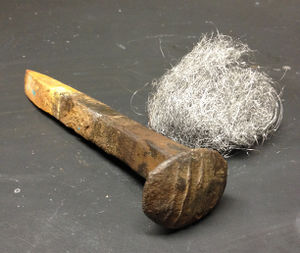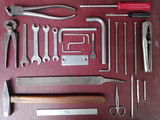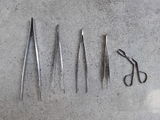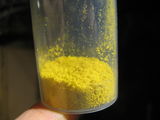Iron
 Two easily available iron sources, with very different surface areas: Steel wool and railroad spikes. | |||||
| General properties | |||||
|---|---|---|---|---|---|
| Name, symbol | Iron, Fe | ||||
| Appearance | Metallic gray | ||||
| Iron in the periodic table | |||||
| |||||
| Atomic number | 26 | ||||
| Standard atomic weight (Ar) | 55.845(2) | ||||
| Group, block | , d-block | ||||
| Period | period 4 | ||||
| Electron configuration | [Ar] 3d6 4s2 | ||||
per shell | 2, 8, 14, 2 | ||||
| Physical properties | |||||
| Metallic gray | |||||
| Phase | Solid | ||||
| Melting point | 1811 K (1538 °C, 2800 °F) | ||||
| Boiling point | 3134 K (2862 °C, 5182 °F) | ||||
| Density near r.t. | 7.874 g/cm3 | ||||
| when liquid, at | 6.98 g/cm3 | ||||
| Heat of fusion | 13.81 kJ/mol | ||||
| Heat of | 340 kJ/mol | ||||
| Molar heat capacity | 25.1 J/(mol·K) | ||||
| pressure | |||||
| Atomic properties | |||||
| Oxidation states | −4, −2, −1, +1, +2, +3, +4, +5, +6, +7 (an amphoteric oxide) | ||||
| Electronegativity | Pauling scale: 1.83 | ||||
| energies |
1st: 762.5 kJ/mol 2nd: 1561.9 kJ/mol 3rd: 2957 kJ/mol | ||||
| Atomic radius | empirical: 126 pm | ||||
| Miscellanea | |||||
| Crystal structure |
Bbody-centered cubic (bcc) a=286.65 pm | ||||
| Crystal structure |
Face-centered cubic (fcc) Between 1185–1667 K | ||||
| Speed of sound thin rod | 5120 m/s (at ) (electrolytic) | ||||
| Thermal expansion | 11.8 µm/(m·K) (at 25 °C) | ||||
| Thermal conductivity | 80.4 W/(m·K) | ||||
| Electrical resistivity | 9.61·10-8 Ω·m (at 20 °C) | ||||
| Curie point | 1043 K | ||||
| Magnetic ordering | Ferromagnetic | ||||
| Young's modulus | 211 GPa | ||||
| Shear modulus | 82 GPa | ||||
| Bulk modulus | 170 GPa | ||||
| Poisson ratio | 0.29 | ||||
| Mohs hardness | 4 | ||||
| Vickers hardness | 608 MPa | ||||
| Brinell hardness | 200–1180 MPa | ||||
| CAS Registry Number | 7439-89-6 | ||||
| History | |||||
| Before 5000 BC | |||||
Iron (chemical symbol Fe) is element number 26 on the periodic table. It is one of the elements known since antiquity, and has long been prized for its strength and ability to form even stronger alloys, such as steel. In the lab, iron can be either a useful reagent or an annoying contaminant. Its coordination chemistry is not as extensive as that of some other transition metals, but several complexes are known.
Contents
Properties
Physical
Iron is a silvery gray metal. It has a melting point of 1538 degrees C. It is commonly known to be ferromagnetic, the word being partially derived from the Latin word for iron. It is known to exist in four allotropes, and it may exist in a fifth. Very pure single-crystal iron, used for research purposes, is far weaker structurally than aluminum metal.
Chemical
Iron forms compounds most commonly found in it's ferrous(II) and ferric(III) oxidation states, but it can exist in the (IV) and (VI) valence states as ferrates. Other oxidation states are possible present no interest to the amateur chemist.
Iron reacts with air in the presence of water to form Fe2O3, commonly known as rust. It also will form mixed valence compounds like magnetite (Fe3O4), that contain both ferrous and ferric state iron in their structure. Magnetite may be produced by ignition of steel wool. Iron reacts with the halogens to form its halide salts. It will also react with sulfur at elevated temperatures if finely divided to form iron sulfide (FeS). In solution, iron tends to form ferrous salts, but the addition of hydrogen peroxide (and often atmospheric oxygen) will promote the formation of ferric compounds.
Iron metal will react with diluted acids, such as hydrochloric acid, but passivates in contact with concentrated acids, such as nitric acid or phosphoric acid.
The ferrous state of iron is normally soluble in water and is resistant to oxidation in acidic solution. In basic solution, however, iron(II) oxide will precipitate and be oxidized by water to iron(III) oxide. Solid iron(II) sulfate may oxidize in air to form iron(III) oxide deposits.
The ferric state of iron is only soluble in acidic solutions and will quickly convert to hydrous iron(III) oxide if the acidity is reduced. This is a source of annoyance for most chemists. However, interesting color changes may occur due to complex formation. One example is iron(III) nitrate: it is lavender in the solid state, but dissolves to form a rust-colored solution, with the dominant iron species being [Fe(H2O)5OH]2+. A small amount of acid will turn this solution clear as the [Fe(H2O)5OH]2+ is converted to [Fe(H2O)6]3+. Ferric compounds, such as iron(III) chloride, are strongly Lewis acidic.
Iron(III) iodide is unstable with respect to disproportionation. When an iodide-containing solution is added to a solution containing ferric ion, iron(II) iodide and iron precipitate.
A relatively sensitive test for ferric iron is the addition of thiocyanates, which form a deep red complex. This can be used to make fake blood as a party trick.
Both oxidation states readily from complexes with water, cyanide, nitrous oxide (ferrous only) and oxalates (ferric only)[1]
Ferrates(VI) are compounds of iron in the +6 state. These are only stable in strongly basic solutions and will degrade after about a day. However, they can be produced at home by using bleach, and can be stabilized by precipitation with barium. Anhydrous ferrates are stable if they are pure; if impure, they quickly decompose even in an anhydrous state, unless the contaminant is a strong alkali, which, on the contrary, works as a stabilizer. Although ferrates are powerful oxidizers, they are mild and will not ignite organic materials.
Ferrates are salts of ferric acid H2FeO4, which is so unstable that it immediately decomposes on formation. The anhydride, FeO3, is also so far impossible to isolate.
Availability
Due to the superior mechanical and chemical properties of steel, most items that contain iron are normally alloys. Some sources of steel wool however, use pure iron metal. Despite sounding like it contains less carbon than steel, "cast iron" contains at least twice as much carbon as high-carbon steel, making it less usable than steel as an iron source. Railroad spikes, cleaned with a file, can serve as bulk iron electrodes for producing solutions of soluble iron compounds, and are totally free. Occasionally pieces of discarded iron can be found near welded railway tracks, which are high purity iron. However, most pieces of iron tend to be lodged in slag, which should be removed.
Preparation
Pure iron can be prepared via the classical thermite reaction.
- Fe2O3 + Al → Fe + Al2O3
The reaction also produces lots of slag as side product.
High purity iron powder can be produced by reducing an iron salt with hydrogen. A more accessible way is via decomposition of iron(II) oxalate. This yields iron carbon dioxide, carbon monoxide, iron(III) oxide (if oxygen is present) and pyrophoric black iron.
Projects
- Making pyrophoric iron via ferrous oxalate
- Prussian blue
- Ferric-thiosulfate complexes
- Thiocyanate complexes
- Making fake blood
- Making ferrates
- Making and using ferric chloride etchants
- Thermite
- Extracting iron from breakfast cereal or dirt
- Making a heating pack
Handling
Safety
Iron in the form of steel wool or powder is highly flammable. Caution must be taken when working with it near an open flame. Its oxides and halides will stain clothing.
Iron is a necessary trace element, found in nearly all living organisms. Iron-containing enzymes and proteins, often containing heme prosthetic groups, participate in many crucial biological oxidations and in transport. Iron is the metal ion in the haemoglobin organometallic complex.
Storage
Iron metal can be stored in open air, but will rust in moist or polluted air. Iron that was cleaned with an acid will quickly rust in air, unless protected. Iron powder can be pyrophoric and should be stored in closed bottles.
Disposal
Iron and iron compounds can be safely dumped in the environment, as they pose little toxicity. Iron halides however, will hydrolyze to release their respective acids and should be neutralized before disposal.
Gallery
Element
Tools made of steel, the most common form of iron encountered.




